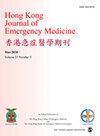Risk factors for venous thromboembolism after carbon monoxide poisoning: A nationwide population-based study
IF 0.8
4区 医学
Q4 EMERGENCY MEDICINE
引用次数: 0
Abstract
Introduction: The risk of venous thromboembolism increases after acute carbon monoxide poisoning. However, studies on the characteristics of patients who develop venous thromboembolism after carbon monoxide poisoning are rare. The aim of this study was to identify the risk factors for venous thromboembolism within 3 months after carbon monoxide poisoning. Methods: This is a population-based study that employed nationwide claims data from South Korea. Among the carbon monoxide poisoning patients (⩾18 years), the characteristics of the groups with and without venous thromboembolism (pulmonary embolism or deep vein thrombosis) were identified. All the significant variables in the univariable analysis were included in the multivariable logistic regression to determine the risk factors for venous thromboembolism occurrence. Results: Among the 24,232 carbon monoxide poisoning patients, 130 subjects developed venous thromboembolism within 90 days of their carbon monoxide poisoning diagnosis. The significant risk factors for venous thromboembolism in the multivariable analysis were age (adjusted odds ratio (aOR) = 1.01; 95% confidence interval (CI) = 1.003–1.03), intensive care unit admission (aOR = 3.80; 95% CI = 2.34–6.12), length of stay (aOR = 1.02; 95% CI = 1.0001–1.04), congestive heart failure (aOR = 2.17; 95% CI = 1.36–3.42), and cancer (aOR = 1.94; 95% CI = 1.10–3.22). The adjusted odds ratios for intensive care unit admission for patients with pulmonary embolism and deep vein thrombosis were 3.05 (95% CI = 1.61–5.61) and 5.60 (95% CI = 2.89–10.90), respectively. Conclusion: Patients with older age, intensive care unit admission, a longer length of stay, congestive heart failure, or cancer are at greater risk of developing venous thromboembolism after carbon monoxide poisoning. In particular, intensive care unit admission was the strongest risk factor for venous thromboembolism, pulmonary embolism, and deep vein thrombosis. Monitoring and administering prophylactic treatments to prevent venous thromboembolism would be helpful in high-risk in carbon monoxide poisoning patients.一氧化碳中毒后静脉血栓栓塞的危险因素:一项基于全国人群的研究
简介:急性一氧化碳中毒后静脉血栓栓塞的风险增加。然而,关于一氧化碳中毒后发生静脉血栓栓塞的患者特征的研究很少。本研究的目的是确定一氧化碳中毒后3个月内静脉血栓栓塞的危险因素。方法:这是一项基于人群的研究,采用了来自韩国的全国索赔数据。在一氧化碳中毒患者(大于或小于18年)中,确定了有和没有静脉血栓栓塞(肺栓塞或深静脉血栓形成)的组的特征。将单变量分析中的所有显著变量纳入多变量logistic回归,以确定静脉血栓栓塞发生的危险因素。结果:24232例一氧化碳中毒患者中,130例在一氧化碳中毒诊断后90天内发生静脉血栓栓塞。多变量分析中静脉血栓栓塞的显著危险因素为年龄(校正优势比(aOR) = 1.01;95%可信区间(CI) = 1.003-1.03),重症监护病房入院(aOR = 3.80;95% CI = 2.34-6.12)、住院时间(aOR = 1.02;95% CI = 1.0001-1.04),充血性心力衰竭(aOR = 2.17;95% CI = 1.36-3.42)和癌症(aOR = 1.94;95% ci = 1.10-3.22)。肺栓塞和深静脉血栓患者入住重症监护病房的校正优势比分别为3.05 (95% CI = 1.61-5.61)和5.60 (95% CI = 2.89-10.90)。结论:年龄较大、入住重症监护病房、住院时间较长、充血性心力衰竭或癌症患者发生一氧化碳中毒后静脉血栓栓塞的风险较大。特别是,重症监护病房入住是静脉血栓栓塞、肺栓塞和深静脉血栓形成的最强危险因素。监测和实施预防性治疗以预防静脉血栓栓塞对一氧化碳中毒高危患者有帮助。
本文章由计算机程序翻译,如有差异,请以英文原文为准。
求助全文
约1分钟内获得全文
求助全文
来源期刊

Hong Kong Journal of Emergency Medicine
EMERGENCY MEDICINE-
CiteScore
1.50
自引率
16.70%
发文量
26
审稿时长
6-12 weeks
期刊介绍:
The Hong Kong Journal of Emergency Medicine is a peer-reviewed, open access journal which focusses on all aspects of clinical practice and emergency medicine research in the hospital and pre-hospital setting.
 求助内容:
求助内容: 应助结果提醒方式:
应助结果提醒方式:


